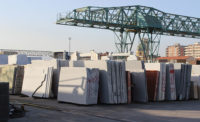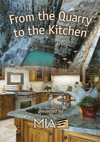My first trip to Carrara took place around seven years ago, although it wasn't for the trade fair. I had the privilege of participating in a press tour of the area's renowned white marble quarries and stoneworking operations. At the time, I was taken aback by the sheer size of the stone industry in Carrara -- as I still am today. The mountains of the Apuan Alps are literally covered with quarries, and their rounded white peaks make them appear snow capped, even though this look was actually brought about by centuries of stone quarrying.
Moving away from the quarries, closer to the sea, the factories of the Carrara region demonstrate why they are such excellent keepers of Michelangelo's heritage in stone. Just as Michelangelo carefully crafted stone from the nearby quarries, the stoneworking plants in the area skillfully create works for natural stone with the utmost precision. Of course, now these stoneworkers are bringing in materials from all over the world, and much of their work -- tiles, slabs, architectural pieces -- is tailored to suit the needs of the 21st century marketplace.
The reason I am waxing poetic about Carrara is because the CarraraMarmotec fair has come under question by members of the stone industry over the past few years. With so many international trade fairs for the natural stone industry, there are those that feel that there are simply too many events to handle, and some fairs need to either reduce their schedule (perhaps becoming biennial instead of annual) or shut down altogether.
While I certainly understand these concerns (I travel to most of these international fairs myself), I think many stone industry members would be remiss to leave Carrara off their travel schedule every year. During my seven days in Carrara this past June, I not only attended the fair, but I saw an incredibly diverse range of stoneworking operations, which I am happy to be sharing with our readers in this issue of Stone World.
Companies I visited included a specialist in unique and exotic stone materials (page 114); a plant specifically for applying resin to marble and granite slabs (page 126); an underground quarry extracting some of the region's finest marbles (page 130); and a producer of architectural stone that has supplied some of North America's most prestigious skyscrapers (page 136). All of these firms were within a short drive of the fairgrounds, and of particular note to our readership, all of the stone fabricators have specifically targeted North America as a key consumer of their exports.
In early October, the international stone industry will descend on another Italian trade fair, Marmomacc in Verona (page 164). This fair also takes place in an historic stoneworking center, near the quarries for the renowned Rosso Verona and Breccia marbles. Additionally, the Verona region is equally rich in advanced stoneworking firms, who are using the latest machinery and techniques to fabricate stone products for export. Fortunately, however, this successful fair has been heralded as a leading event in the international marketplace, and it is certain to continue in its present state for years to come. Visitors to Marmomacc would do well to make appointments with local producers in addition to attending the fair.
So as the North America stone industry continues to grow, its members can benefit by exploring areas such as Carrara and Verona, and perhaps the regions' respective fairs can serve as a springboard to such explorations.





